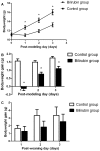A novel newborn rat kernicterus model created by injecting a bilirubin solution into the cisterna magna
- PMID: 24796550
- PMCID: PMC4010446
- DOI: 10.1371/journal.pone.0096171
A novel newborn rat kernicterus model created by injecting a bilirubin solution into the cisterna magna
Abstract
Background: Kernicterus still occurs around the world; however, the mechanism of bilirubin neurotoxicity remains unclear, and effective treatment strategies are lacking. To solve these problems, several kernicterus (or acute bilirubin encephalopathy) animal models have been established, but these models are difficult and expensive. Therefore, the present study was performed to establish a novel kernicterus model that is simple and affordable by injecting unconjugated bilirubin solution into the cisterna magna (CM) of ordinary newborn Sprague-Dawley (SD) rats.
Methods: On postnatal day 5, SD rat pups were randomly divided into bilirubin and control groups. Then, either bilirubin solution or ddH2O (pH = 8.5) was injected into the CM at 10 µg/g (bodyweight). For model characterization, neurobehavioral outcomes were observed, mortality was calculated, and bodyweight was recorded after bilirubin injection and weaning. Apoptosis in the hippocampus was detected by H&E staining, TUNEL, flow cytometry and Western blotting. When the rats were 28 days old, learning and memory ability were evaluated using the Morris water maze test.
Results: The bilirubin-treated rats showed apparently abnormal neurological manifestations, such as clenched fists, opisthotonos and torsion spasms. Bodyweight gain in the bilirubin-treated rats was significantly lower than that in the controls (P<0.001). The early and late mortality of the bilirubin-treated rats were both dramatically higher than those of the controls (P = 0.004 and 0.017, respectively). Apoptosis and necrosis in the hippocampal nerve cells in the bilirubin-treated rats were observed. The bilirubin-treated rats performed worse than the controls on the Morris water maze test.
Conclusion: By injecting bilirubin into the CM, we successfully created a new kernicterus model using ordinary SD rats; the model mimics both the acute clinical manifestations and the chronic sequelae. In particular, CM injection is easy to perform; thus, more stable models for follow-up study are available.
Conflict of interest statement
Figures





Similar articles
-
A new rat model of neonatal bilirubin encephalopathy (kernicterus).J Pharmacol Toxicol Methods. 2017 Mar-Apr;84:44-50. doi: 10.1016/j.vascn.2016.10.002. Epub 2016 Oct 13. J Pharmacol Toxicol Methods. 2017. PMID: 27746217
-
Minocycline blocks acute bilirubin-induced neurological dysfunction in jaundiced Gunn rats.Neonatology. 2007;92(4):219-26. doi: 10.1159/000103740. Epub 2007 Jun 8. Neonatology. 2007. PMID: 17556840
-
The Blockade of NF-κB Activation by a Specific Inhibitory Peptide Has a Strong Neuroprotective Role in a Sprague-Dawley Rat Kernicterus Model.J Biol Chem. 2015 Dec 11;290(50):30042-52. doi: 10.1074/jbc.M115.673525. Epub 2015 Oct 23. J Biol Chem. 2015. PMID: 26499797 Free PMC article.
-
Kernicterus and the molecular mechanisms of bilirubin-induced CNS injury in newborns.Neuromolecular Med. 2006;8(4):513-29. doi: 10.1385/NMM:8:4:513. Neuromolecular Med. 2006. PMID: 17028373 Review.
-
The neurotoxicity of bilirubin.Clin Perinatol. 1990 Jun;17(2):437-47. Clin Perinatol. 1990. PMID: 2196139 Review.
Cited by
-
Bilirubin impairs neuritogenesis and synaptogenesis in NSPCs by downregulating NMDAR-CREB-BDNF signaling.In Vitro Cell Dev Biol Anim. 2024 Mar;60(2):161-171. doi: 10.1007/s11626-023-00844-5. Epub 2024 Jan 12. In Vitro Cell Dev Biol Anim. 2024. PMID: 38216855
-
A zebrafish model for studying the mechanisms of newborn hyperbilirubinemia and bilirubin-induced neurological damage.Front Cell Dev Biol. 2023 Nov 14;11:1275414. doi: 10.3389/fcell.2023.1275414. eCollection 2023. Front Cell Dev Biol. 2023. PMID: 38033855 Free PMC article.
-
H3K18 lactylation-mediated nucleotide-binding oligomerization domain-2 (NOD2) expression promotes bilirubin-induced pyroptosis of astrocytes.J Neuroinflammation. 2025 Mar 12;22(1):76. doi: 10.1186/s12974-025-03399-2. J Neuroinflammation. 2025. PMID: 40075479 Free PMC article.
-
Evaluation of region selective bilirubin-induced brain damage as a basis for a pharmacological treatment.Sci Rep. 2017 Jan 19;7:41032. doi: 10.1038/srep41032. Sci Rep. 2017. PMID: 28102362 Free PMC article.
-
Experimental models assessing bilirubin neurotoxicity.Pediatr Res. 2020 Jan;87(1):17-25. doi: 10.1038/s41390-019-0570-x. Epub 2019 Sep 7. Pediatr Res. 2020. PMID: 31493769 Review.
References
-
- American Academy of Pediatrics (2004) Management of hyperbilirubinemia in the newborn infant 35 or more weeks of gestation. Pediatrics 114: 297–316. - PubMed
-
- Johnson L, Bhutani VK, Karp k, Sivieri EM, Shapiro SM (2009) Clinical report from the pilot USA Kernicterus Registry (1992 to 2004)Root causes of kernicterus. J Perinatol 29 Suppl 1S25–45. - PubMed
-
- Sgro M, Campbell DM, Kandasamy S, Shah V (2012) Incidence of chronic bilirubin encephalopathy in Canada, 2007–2008. Pediatrics 130(4): e886–90. - PubMed
-
- Liu KZ, He HY, Hua ZY (2012) Clinical analysis of acute bilirubin encephalopathy in 227 neonates. J Clin Pediatr (in Chinese) 30(9): 840–844.
Publication types
MeSH terms
Substances
LinkOut - more resources
Full Text Sources
Other Literature Sources
Medical

